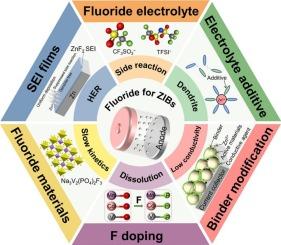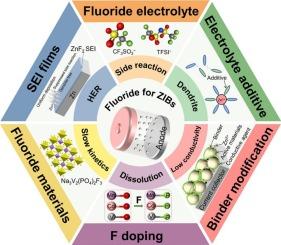Fluoride engineering in zinc-ion batteries: principles, strategies, and perspectives
IF 23.5
1区 化学
Q1 CHEMISTRY, INORGANIC & NUCLEAR
引用次数: 0
Abstract
Zinc-ion batteries (ZIBs) are considered promising candidates for the next-generation energy storage technology due to their high safety, low cost, and high theoretical capacity. However, its practical application is hampered by irregular dendrite growth, hydrogen evolution reaction (HER), and passivation on the anode, as well as the poor structural stability and sluggish kinetics of the cathode. This review systematically investigates the multifunctional roles of fluoride engineering in ZIBs from a holistic “anode-interface-electrolyte-cathode” perspective, encompassing interface regulation and material design. The fluoride-modification of zinc anode is first discussed, including suppression of dendrite growth, reduction of side reactions, and enhancement of ion transport kinetics. Subsequently, fluoride-based interface engineering and fluoride electrolyte optimization are summarized, covering inorganic fluorine-rich solid-electrolyte interphase (SEI) films, inorganic-organic composite fluorine-rich SEI films, and two design strategies for SEI films. Furthermore, the review summarizes fluoride-related cathode design strategies, including fluorine doping, fluoride-based active materials and binder modification. Finally, a brief summary of the current challenges associated with fluorides in ZIBs research, and theoretical insights and technical prospects for the rational design of high-performance ZIBs are prospected.


锌离子电池中的氟化物工程:原理、策略和观点
锌离子电池(zib)因其高安全性、低成本和高理论容量而被认为是下一代储能技术的有前途的候选人。然而,它的实际应用受到不规则枝晶生长、阳极析氢反应(HER)和钝化以及阴极结构稳定性差和动力学缓慢的阻碍。本文从“阳极-界面-电解质-阴极”的整体角度,包括界面调节和材料设计,系统地研究了氟工程在ZIBs中的多功能作用。首先讨论了锌阳极的氟化改性,包括抑制枝晶生长、减少副反应和增强离子传输动力学。随后,总结了基于氟的界面工程和氟电解质优化,包括无机富氟固体电解质界面(SEI)膜、无机-有机复合富氟SEI膜以及SEI膜的两种设计策略。此外,综述了氟阴极的设计策略,包括氟掺杂、氟基活性材料和粘结剂改性。最后,简要总结了目前ZIBs研究中与氟化物相关的挑战,并展望了合理设计高性能ZIBs的理论见解和技术前景。
本文章由计算机程序翻译,如有差异,请以英文原文为准。
求助全文
约1分钟内获得全文
求助全文
来源期刊

Coordination Chemistry Reviews
化学-无机化学与核化学
CiteScore
34.30
自引率
5.30%
发文量
457
审稿时长
54 days
期刊介绍:
Coordination Chemistry Reviews offers rapid publication of review articles on current and significant topics in coordination chemistry, encompassing organometallic, supramolecular, theoretical, and bioinorganic chemistry. It also covers catalysis, materials chemistry, and metal-organic frameworks from a coordination chemistry perspective. Reviews summarize recent developments or discuss specific techniques, welcoming contributions from both established and emerging researchers.
The journal releases special issues on timely subjects, including those featuring contributions from specific regions or conferences. Occasional full-length book articles are also featured. Additionally, special volumes cover annual reviews of main group chemistry, transition metal group chemistry, and organometallic chemistry. These comprehensive reviews are vital resources for those engaged in coordination chemistry, further establishing Coordination Chemistry Reviews as a hub for insightful surveys in inorganic and physical inorganic chemistry.
 求助内容:
求助内容: 应助结果提醒方式:
应助结果提醒方式:


